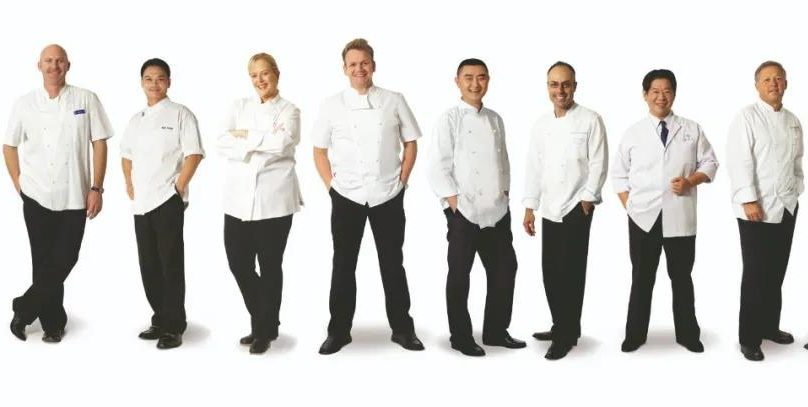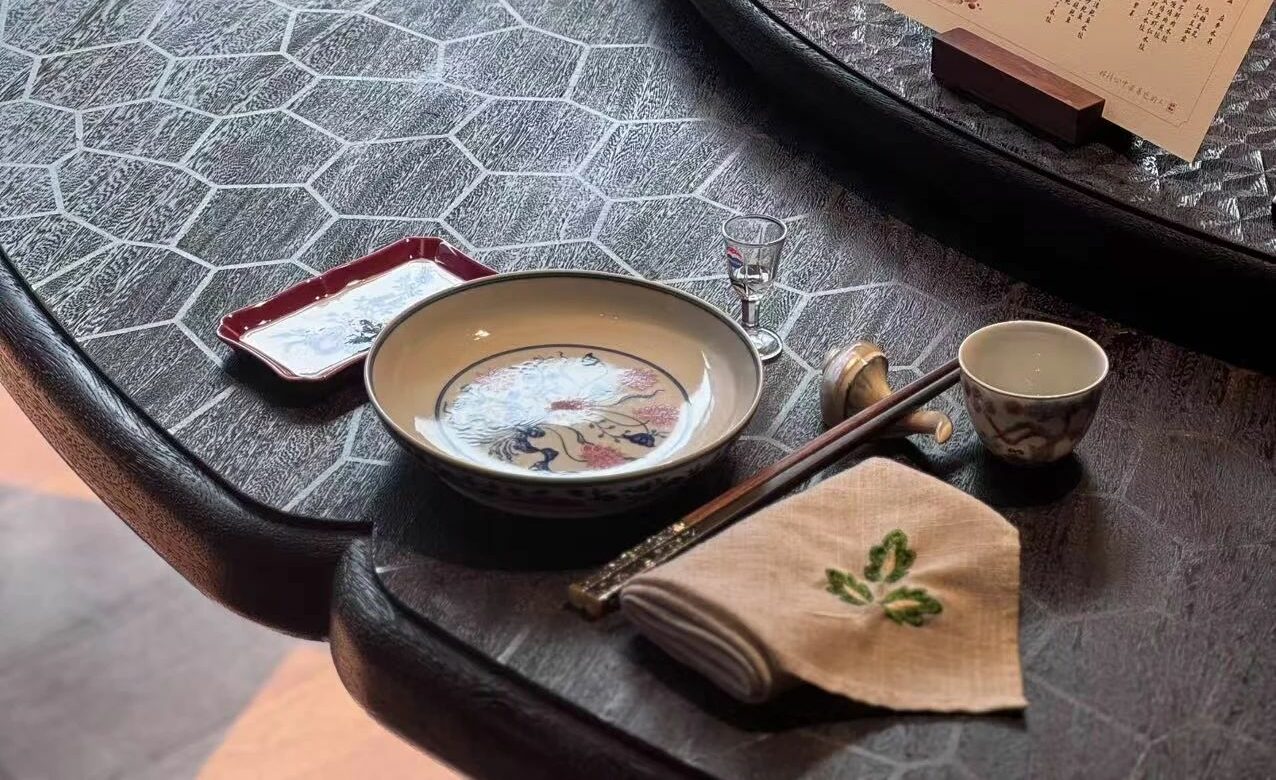Over the past few years, Shanghai’s culinary landscape has had its pivot shifted from foreignization to the rich tapestry of China’s own food heritage. Nicknamed as “Mr Shanghai”, the handsome chef Zhu Jun started his own restaurant The Hut six years ago, which has now become a proven representative for new Huaiyang cuisine. Zhu comes from the high-end catering world but has envisioned to build up his business steadily and surely through the affordable dishes at The Hut and exciting projects ahead.
The Beginning of New Huaiyang Cuisine
Huaiyang cuisine (also literati cuisine) is derived from the native cooking styles of the region surrounding the lower reaches of the Yangtze River and centred on the cities of Huai’an, Yangzhou and Zhenjiang in Jiangsu Province. As one of the country’s four major cuisines, it’s regional because it rose from southeast China, yet its flavours are that of the world level in every sense of the term. In 2015, Zhu Jun, who has worked in the restaurant industry for 30 years and has acquired due fame, decided to carve out his own niche market for new Huaiyang cuisine in Shanghai’s competitive culinary scene.

Zhu Jun wearing chef uniform
Before The Hut, Zhu started to work in the kitchen simply out of his parents’ urge for him to develop personal skills. Perhaps because running chores in the kitchen was too hard, he questioned his choice. He mentioned that in the first few years he didn’t sure about being a chef, whether he should develop other talents, such as singing and painting [laugh].
Nothing was purposefully planned. Zhu Jun’s success today is due to the fact that every step he took was solid and he managed to endure the hardship. Zhu said that the time spent doing apprenticeship was much longer at his time than what it is now. Likely due to high market demand, trainees can be on their own after two or three years. He trained for five years before becoming a chef, and each specialty needed another three years to hone.
Zhu told me that being an apprentice in the kitchen was probably the least favourite career choice for a young man full of big dreams and ambition. He first worked in a well-known Shanghai restaurant whose kitchen was supervised by an experienced senior chef who used to work at one of most prestigious restaurants in Shanghai and was already in his eighties. At the time, part of Zhu’s job included cleaning up the workbench surface, and he would get scolded for not doing it right. Instead of getting hold back by the hard work, he set his eyes on the bigger picture.
This experience has brought him further in the restaurant industry, which is compared as the world of martial arts by Zhu because both worlds emphasise origin. Just like there are different schools of Chinese kung fu, the culinary sector has eight major cuisine categories. Young people tend to hop between different cuisine categories before finally settling on a specific field. And once they do this, they are often judged by which restaurant they are from and what cuisines they have mastered. Zhu’s experience working at the Shanghai restaurant turned out to be a substantial helping hand.
Zhu’s apprenticeship involved learning Sichuan-Huaiyang cuisine, a popular choice among Chinese restaurants at that time, and Fujian cuisine, because the head chef was from Fujian. This has established his knowledge on Huaiyang cuisine. Soon after leaving the Shanghai Restaurant, he took on the role of head chef at a tender age of 22, managing a kitchen of over ten people and embracing positive life changes brought by the high-paying job. Besides, it’s worth mentioning that the restaurant he worked at successfully grew to a popular restaurant chain in the city during his time.
Michelin One Star in 2010
Zhu later joined Jardin de Jade, a high-end restaurant brand from Shanghai whose Macau outlet was recognised as a one-star establishment in the Michelin Guide 2010, making it the first ever Mainland receiver of a Michelin star. Soon, Zhu’s fame began to grow as he went on to lead the kitchen as the head chef of the restaurant group. Zhu said the only recipe for success is focus on what you are good at; there is no substitute for hard work.
The decision to go back to Huaiyang cuisine was to pave a new path for his life after he turns 40. Zhu said that he had enjoyed a lot of accolades and recognition for his work at Jardin de Jade, but he felt the urge to find new challenges in life, to promote a cuisine that is more representative of the Yangtze River Delta region. Huaiyang cuisine turned out to be the obvious answer, given its top position among all eight major Chinese cuisines, and a rich bank of resources that Zhu has accumulated throughout the years to make it really work.
Despite stereotypes such as lion’s head and boiled dried bean curd slices as typical Huaiyang dishes, Zhu believes that new Huaiyang cuisine should cover the whole Jiangnan area, including Shanghai. He believes that people in the Northeast, Shanghai, Guangdong & Hong Kong & Macau, the Northwest and Sichuan, given their living conditions and culture background, have different dining habits and preference for flavours.

Zhu Jun (Left) and writer
Oriental Aesthetics
People in the Jiangnan region have their own understanding of food. As a native Shanghainese who has witnessed many significant changes in Chinese cuisine over the years, he hopes to bring the authentic flavours of Jiangnan cuisine to more diners. “New Huaiyang cuisine helps people understand the mainstream, popular trends in the kitchen, and that is, using local ingredients while combining international cooking techniques with traditional skills.” Zhu Jun said.
“By saying ‘combining’ we don’t mean this is going to be easy,” Zhu Jun added, “Chinese food should be, after all, Chinese. Internationalisation plays a part, but it stands to showcase the elegance, the connotation and cultural heritage of the country. Japanese cuisine is known for its extensive use of minimalism, behind which vast amount of process and craftsmanship are invested, as should be the case with high-end Chinese cuisine.”
According to Zhu Jun, today’s Chinese cuisine is pursuing the artistry of Western plating and has lost the originality of Chinese cuisine which values heat control. He studied French and Italian cuisine for two years and therefore is familiar with the fundamentals of Western cuisine. He has always believed that the aesthetics of Western plating is still dominated by the French, while the aesthetics of Chinese cuisine should be decided by oriental perspectives.
Emersed long enough to see the great changes in Shanghai’s catering industry over the past 30 years, Zhu Jun knows the importance of being down-to-earth and being able to look further. Shanghai’s restaurant industry has developed from the flourishing of traditional cuisines in the 1990s to the current era of refining and upgrading of regional cuisines since 2020.
The Hut’s Huaiyang cuisine is more in line with the modern palate – non-oily, light and fresh. Efficiency has been largely improved by the adoption of Western-style ovens in the kitchen. Zhu Jun said, success is not all about chasing after cooking trends; you must first cater to the marketplace, and then make yourself different.
The cuisine at The Hut is pure and elegant, with complexity as well as creativity. It demonstrates an independent thinking that is currently missing in the Chinese food sector, and it deserves to be housed in independent premises, rather than a corner of a posh shopping centre. Zhu Jun is deeply versed in philosophy, talking about the final destination of life endeavours, and he believes that everyone has the right to enjoy exquisiteness, and that The Hut exists to go the extra mile. Expectations are high for The Hut. Zhu indicated that there will be high-end branches as soon as the groundwork is laid well.
Many dishes impressed me with masterful knife skills that are involved. I remember the foreign chefs who were with me that day were stunned as well and asked quite a few times how long it would take to make such dishes. Shredded Chicken with Courgette and Jellyfish is the first cold dish we had. Golden Yunnan courgette is slightly salted and turned into a vivid golden fish to be wrapped in cold shredded chicken and sand ginger-flavoured jellyfish for a refreshing delight. The dish draws an auspicious reference from a traditional Chinese saying – “carp leaping over the dragon gate”, to wish promotion or high grades.
With an implication of “the first stroke of luck”, piglet of premium quality is selected and handled with secret-recipe seasonings and a variety of methods including marinating, roasting and brining. The meat is delicate and soft with an innovative local braised flavour and served with ginger slices and vinegar.

Shredded Chicken with Courgette and Jellyfish

Gravy Piglet
The Hut takes on the timeless lion’s head with innovation to replace the pork with yellow croaker, a healthier alternative for higher protein content to cater to the modern palate. The dish is tender, creamy, perfumed with aromatic matsutake mushroom soup and highlighted by an interesting finishing touch of satay small wontons.
Sautéed Fine Shredded Mandarin Fish with Shredded Hum & Vegetables is a widely creative signature dish at The Hut. It uses five different ingredients to accompany shredded Mandarin fish, namely shredded ham, shredded bamboo shoots, shredded green pepper, egg slices and black fungus. All the ingredients would make a debut at the table before stir fried in a ceramic pan. The Hut presents this dish in a beautifully plated form that constructs a perfect rendering of colour, aroma, taste, meaning and style.
My chef friends were deeply amazed by Crispy Smoked Chicken with Tea Leaves, a Cantonese-inspired fusion cuisine with a touch of Huaiyang chef’s witty ideas. The whole chicken is first dehydrated, smoked with Longjing tea, soaked in crispy-skin sauce, hanged and air-dried, etc.. With six stages of cooking, the chicken features bright red, crispy skin and white, tender meat, with a mellow whiff of green tea. This dish demonstrates precise control over the seasoning and cooking techniques.

Yellow Croaker Lion’s Head

Sautéed Fine Shredded Mandarin Fish with Shredded Hum & Vegetables

on-site cooking Sautéed Fine Shredded Mandarin Fish with Shredded Hum & Vegetables

Crispy Smoked Chicken with Tea Leaves
The Hut has four venues in Shanghai with the fifth on the way. Usually, it takes seven to ten days to book a private room at the restaurant. When asked whether there are plans to expend in other cities, Zhu Jun resorted to a steady growth strategy, “There’s no greater danger than expansion without a good team. Brand value is above everything, and we need to be able to have that in control.”
The Only Chinese Consultant in the International Culinary Panel of Singapore Airlines

Being the only Chinese consultant in the International Culinary Panel of Singapore Airlines (The fifth from the right) @Singapore Airlines
Becoming a consultant for Singapore Airlines was another milestone. As one of the world’s leading airlines, Singapore Airlines is renowned for its service and in-flight catering. As the only Chinese consultant after Yang Guanyi in the International Culinary Panel of Singapore Airlines, Zhu Jun is considered to be one of the best chefs in the world. Zhu mentioned that when the airline came to him ten years ago, they had been reviewing his restaurant for a year. Being a member of advisory committee for the airline was a great boost to his reputation home and abroad.
To me, Zhu Jun is insightful, humorouus and he can get serious when talking about business. As a Shanghai local, he is always decent, elegant, with extensive social contacts. The Hut hosts annual crab feast as a cultural event among the art circles. With rich life experience, Zhu has carved out an excellent taste for many things, which has in a way justified his nickname – Mr Shanghai.

Mr. Shanghai
Michelin Star Potential
Zhu Jun describes himself by his love of life. He has been concentrating in business management and seldom shows up in public events. Even though Jardin de Jade picked up a Michelin star, Zhu believes that the Guide has not yet been able to fully recognize all Chinese restaurants with star capacity, which I agree. The Hut offers an affordable menu, but the ingredients it uses are far better than their affordable counterparts, for instance it chooses apremium noodle brand as it’s noodle supplier . Even though the restaurant is highly rated among its peers, still it’s yet to be acknowledged by the Michelin Guide.
Zhu recalled when he first started his career, he had only one thought – to pursue one thing at a time. What he has achieved is not something he had expected. His employees have worked with him for many years since he started the business, and he is not in a hurry to expand for he is clear what he needs to do.
Let’s look forward to the high-end establishment of The Hut so that savvy Michelin inspectors won’t miss out on its star potential.











